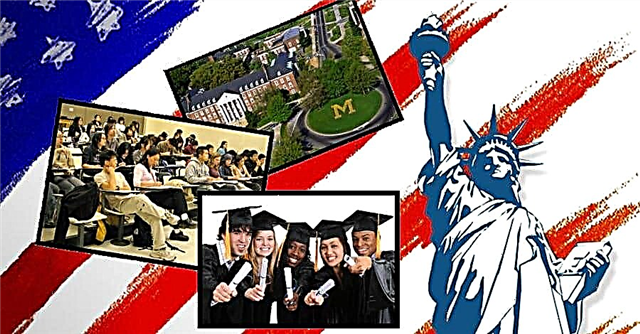Higher education in the United States is one of the most prestigious and high-quality on the planet. In the rankings over the past 10 years, about a quarter of universities in the top 100 of the best educational institutions are American, and the top 10 constantly includes MIT, Stanford, Harvard, California Technical and Chicago universities.
The United States is home to some of the world's largest companies, so local university graduates are guaranteed attention from giants such as Apple, Ford, Alphabet, Tesla, and more. Often, promising students are taken away immediately after graduation. American education is quoted in all countries of the world: after returning home after training, you can count on a good position or internship in your specialty in almost any company.
Among other things, studying in the United States provides a rich practice of English, and this significantly expands the area of looking for a job in the future. A significant number of Russians, Ukrainians, Kazakhstanis and other nationalities of the CIS countries study at large private universities.
Higher education
The structure of higher education in the United States is built according to the British standard. The beginning and end of the academic year is highly dependent on both the state and the university itself, which has been given relatively large freedom in organizational matters. The start of the school year is often tied to Labor Day, celebrated on the first Monday in September.

The study itself is divided into two semesters:
- Autumn, passing from August-September to December;
- Spring, ranging from January-February to June.
Winter vacations last up to three weeks, summer ones - up to three months. Some universities use a 4-1-4 trimester system with an “internship” month in January.
The educational process is strongly distinguished by its orderliness and systematicity in comparison with Russian educational institutions. The student knows in advance the entire program, the schedule of subjects for the year ahead, the teachers and their requirements. Subjects can be run both simultaneously and sequentially, with intensive training in something specific for a month and a closing test.
In addition to a number of compulsory subjects, there are electives with some freedom of choice. So, in order to obtain a higher education in Computer Science, you will have to study in two humanitarian modules of your choice, for example, sociology and philosophy.
Each subject has its own requirements - it will not work to deal with computers without passing at least a C in physics. Education in specialized universities, like the same MIT, may differ: usually they do not allow you to choose electives, and the failure of just one module can lead to abandonment for the second year.
Up to five tests are held per semester in the chosen module, depending on its complexity and importance, plus a final exam. On average, about 2-3 intermediate tests are taken per week, which can be skipped or rescheduled only with a medical certificate. Cheating is severely punished from the complete blockage of the item to expulsion with entry into a personal file. Unusual for Russians is the fact that the test cannot be retaken - the "overwhelmed" subject will have to be passed again, and its cost may begin from $ 500 and more.

You May Also Like
Educational programs
The applicant should expect three stages of training:
- Bachelor's degree - a four-year study in a specialty with a diploma upon completion;
- Master's degree - deepening or changing a specialty;
- Postgraduate studies are scientific work or teaching.
Since 2000, after Russia joined the Bologna Process, education at Russian universities is also carried out in three stages.
There are several types of American universities:
- Colleges are aimed at educating students at the expense of scientific work. Most of these institutions only offer an initial four-year undergraduate course with no further education options;
- State state universities are at the next level, their mission is to provide relatively inexpensive education to state students;
- Private universities like Harvard or Yale are at the top of the system. To enter such institutions, you will not only have to pass difficult exams, but also pay a lot.
Colleges provide a full-fledged higher education, but to close the upper stages and obtain an advanced degree, you will have to go to university. The usual correspondence learning format does not exist, almost everywhere the correspondence course has been replaced by online education.
Features of admission
You can enter an American university after grades 9 or 10 - for this you must apply to Community College, one of the state community colleges. The student will complete a combined program of two school years and two courses of higher education in the first two years.

After completing the second year, the student is transferred to a private educational institution without any problems. There are no direct age restrictions, as long as the exams are passed.
Eleventh graders have no such restrictions, and they can choose any university they want.
The scheme of admission to an American university with a certificate for 11 classes consists of several steps:
- Choose a university and faculty using one of the world rankings (OS, THE, Shanghai ranking);
- For non-core colleges, a wide range of programs with work internships or even a trimester in another country are possible. Attention should be paid to the number of subjects in the main specialization, the complexity of the entrance requirements and the study itself;
- Register on the websites of the universities of interest, view the requirements and complete information on admission. From the site, it will be possible to submit an online application for admission when all documents are ready;
- Collection of documents varies greatly depending on the faculty, program, the prestige of the institution and the competition. At a minimum, you will need a motivation letter on the topic “why did I choose your university and what I want”, a resume, recommendations from a teacher or employer, a valid exam result TOEFL or IELTS, certificate of previous education;
You May Also Like

- For some specialties, like painting or architecture, you need to build a portfolio or take some additional tests. For example, such are considered SAT and ACT - direct analogue of Russian Unified State Exam and OGE... Universities often credit school subjects automatically, but the more prestigious the educational institution, the more chances that the tests will have to be retaken;
- After filling out all the online application forms, you need to pay a fee for its consideration. The fee may be up to $ 50, which is a confirmation of the seriousness of the applicant's intentions and at the same time protection from "spam" mailing of applications to all universities in a row;
- Wait for a response to the application. Additional paperwork or interviews may be required. If the admission was successful, the university will notify you of enrollment and send information on payment and terms of study. It will take a long time to stand in line for the check, most often the application is sent in the fall, and the successful result will become known in late spring.
Required documents
In addition to the completed application form, the application for admission includes:
- "Transcript" - a notarized list of grades translated into English;
- Translated and certified letters of recommendation, up to three pieces;
- An essay on a topic set by the university. Most often, you need to talk about goals in life, choice of university and specialty;
- Documents confirming the ability of the student or his sponsor to pay for the entire course of study;
- Additional important documents - victory at city Olympiads and higher, sporting achievements, inventions and patents, other confirmation of success.
It may be that in some cases the university will require the provision of other documents:
- Military ID;
- Additional test results, etc.
To study, you will need to obtain a special F1 nonimmigrant visa. Registration will cost 360 dollars:
- 200 for inclusion in the SEVIS database;
- Consular fee of $ 160.
You can start applying for a visa at the US Embassy immediately after receiving an official invitation from a college or university, so that by the time you start your studies you can leave without unnecessary problems.
Tuition fees in 2019
The average cost of paid education varies greatly depending on the prestige of the educational institution:
- The upper limit is set by private universities: an academic year at Harvard will cost about 50 thousand dollars;
- State universities provide a grant program for promising local students, but foreigners will have to pay the full program - from 10 to 20 thousand dollars per year;
- An average college will require $ 2,500 to $ 5,000 per year, which is quite comparable to the payment of a prestigious university in Russia. However, it should be understood that a cheap American college is of little help in finding employment. It is worth entering such educational institutions for students planning to move to the United States permanently, in order to simplify "legalization" in the country.
The pedagogical level of the university directly depends on the level of payment. If in college for 5000 dollars at best, a graduate of the state university will teach, then at Yale or Princeton lectures will be given by renowned scientists and Nobel laureates.

Free education
There are two ways to get free VO in the USA:
- Scholarship / grant. In this case, the scholarship can be issued by the state interested in qualified specialists in a particular field. So, in 2017, more than 250 people studied abroad under the Global Education program. Such scholarships usually have certain conditions - for example, to work after training for 3 years at a Russian specialized enterprise or to finish with certain grades.
- Sponsor.This is training at the expense of a commercial company that needs a qualified employee. Before receiving sponsorship, the company and the applicant sign a contract on further cooperation for several years, after which the debt is partially or completely written off.
Internships and exchange studies
In addition to grant and sponsorship options, there are many special internship and study programs available. For example, a Russian has access to the Intern Program, which allows him to work and exchange experience in the United States for a period of two months to one and a half years. Or widely known Summer work and travel, allowing you to travel to another country in the summer, combining earnings and travel. The search for internships is possible on the main J-1 exchange programs.
Scholarships and grants for foreigners
Having arrived to study, a foreigner can take advantage of a need-based scholarship or a scholarship for those in need. The amount of payments and conditions vary from state to state, while the student will have to prove with documents that he is really in a financial situation. In addition, high-performing students can receive scholarships for part-time work at the university, for example, assisting in research or reviewing papers for junior courses (assistantship).
Among the named large programs, a short list can be distinguished:
- Fulbright program, which issues grants to study in 160 countries on a competitive basis;
- Patrick Henry Grantprovided to writers and scholars working on books on American history and culture;
- Yale University Program to search for leaders, the selection criterion is career success;
- UGRAD, an international undergraduate exchange program for undergraduates with full cost coverage, accommodation and meals.
In addition to large scholarships, self-respecting universities offer their own, personal options for applicants from other countries. As a result, about one out of forty applicants with the highest score gets the scholarship, so you should definitely try all the options.
Athletes, Olympiads, gold medalists, or those with a high exam GPA have good chances ACT and SAT.
Accommodation and food options
With housing and meals, everything is very individual: each educational institution itself determines the conditions for the provision of dormitories and meals in the university canteen. Living together in a hostel is the norm - in American culture, this is considered an important part of the student experience. Renting your own home would be a universal option, but in the capitals of the state it will cost a lot and force you to take a serious part-time job, which will interfere with your studies.

Among foreigners, the Au Pair program is popular, which allows you to live with an American family. If approved, most of the questions about food, accommodation and part-time jobs are removed. From the requirements - up to 45 hours of supervising a child of preschool or adolescent age per week and easy manual labor around the house (cooking, washing, cleaning). Often the program ends with final immigration.
How much money does it take to live on average? The minimum living expenses are about a thousand dollars if there is already a house and one and a half thousand if it is not there. The minimum wage in the United States is $ 8 an hour.
Top universities in the country
The best US universities that are consistently included in the top 10 world rankings for the quality and prestige of education:
- MIT, web.mit.edu, founded in 1861, is the most prestigious technical university in the world. Excellent Academic Reputation and Students from Around the World - 96% of students at MIT are non-US citizens. Located in Cambridge, Massachusetts.
- Stanford University, www.stanford.edu, opened in 1891, the second most popular university in the United States after Harvard, known as a university of economics with a focus on real business. Alumni include many founders of large corporations. Located in the heart of Silicon Valley, California.

- Harvard University, www.harvard.edu, the oldest and most popular university in the United States among applicants, dating back to 1636. More than 40 Nobel laureates have studied or taught within the walls of Harvard, and the university library is the largest in the world. It is a neighbor of MIT in Cambridge, Massachusetts.
- California Institute of Technology, www.caltech.edu, a competitor to MIT and one of the largest engineering training centers in the United States since 1891. Among the alumni and teachers there are 31 Nobel laureates. Caltech works closely with NASA, and is famous in the scientific community for its jet propulsion laboratory, seismological research and an international network of observatories.

- University of Chicago, www.uchicago.edu, a private educational institution opened in 1890 with the active participation of John D. Rockefeller. This university is consistently in the top 10 of the best educational institutions in the world, having graduated 87 Nobel Prize winners in its entire history.
- Princeton University, www.princeton.edu, an Ivy League member and one of the best educated universities in the world. The fourth oldest educational institution in the United States, Princeton was founded in 1746. Strong in the humanities and politics, the university regularly trains government leaders and political leaders.

Reviews about studies
Students from the CIS most often celebrate the opportunity to meet people from all over the world and a wide range of opportunities.
Elena, RussiaA: The teachers are clearly interested in our success and learning. Probably, this is because of decent wages and respect in society - a teacher in Salt Lake City is not just the name of a profession, it is more a title, a vocation.In the USA, up to a certain limit, the educational program is formed by the student himself, so everyone takes from the university as much as he can carry.
Nikolay, Kazakhstan: The approach to learning in Astana and New York is almost incomparable. If we have a higher education - rather a duty, without which it will be more difficult to get a job in life, then in the USA it is a tool that will help you work more efficiently. Over the course of four years, in addition to my studies, I met several future colleagues, took internship in two large companies and participated in a startup, which was directly or indirectly encouraged by the teachers.
Daniil, Russia:There is a lot of optimism and positiveness around. Univer is not a place for stress or problems, here they get interesting knowledge and make friends. I want to live twice as fast in order to keep up with the others around.
The American educational system is as rich and practical as possible. A higher education diploma from the United States will be an excellent springboard to a successful career anywhere in the world.











